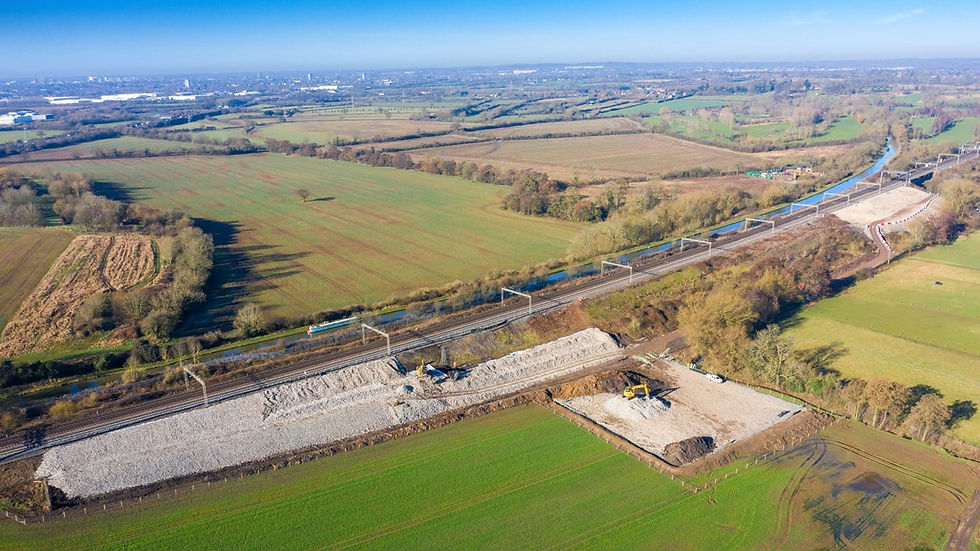Stonehaven Derailment: Could Drones be the Answer?
- rodneypitt9
- Mar 25, 2021
- 3 min read

The line at the scene of the crash was repaired and reopened to trains in November (Network Rail Scotland)
Drones and helicopters should be used more often for railway inspections, an investigation launched after the Stonehaven crash has recommended. A task force led by civil engineer Lord Robert Mair, of the University of Cambridge, has examined the management of railway cuttings and embankments. In a report, the group said aerial checks could help identify problems.
Three people died and six were injured when a train travelling from Aberdeen crashed into a landslip last year. The incident close to Carmont, near Stonehaven in Aberdeenshire, on 12 August followed heavy rain. Driver Brett McCullough, 45, conductor Donald Dinnie, 58, and passenger Christopher Stuchbury, 62, died when the 06:38 Aberdeen to Glasgow Queen Street train crashed and derailed.
Network Rail's interim report on the crash found that the train "struck a pile of washed-out rock and gravel before derailing".
Lord Mair's UK government-commissioned report said "shortfalls in the earthwork examination and risk evaluation system need to be addressed", with "significant investment" required to update the company's monitoring and surveillance methods.
"More regular and frequent use" should be made of helicopters and drones to identify problems, his task force suggested.
The report was published alongside a study into the impact of heavy rainfall on the railway.
A total of more than 50 safety recommendations were made to Network Rail in the report.
Martin Frobisher, Network Rail's safety and engineering director, said: "It is clear that extreme weather presents a significant challenge to the way we safely and reliably manage railway infrastructure. We do a vast amount to tackle the effects of climate change already but there is more to do. We established two independent, expert task forces led by world-class specialists to investigate the problems we face and, crucially, to guide us as we make substantial improvements. We will carefully consider every single recommendation and develop a science-backed improvement plan, to target available money and technology in the best possible way. This is a real breakthrough."
UK Transport Secretary Grant Shapps said: "We must do everything we can to keep our railways safe."
He added: "These findings will inform our work as we push ahead with measures to make our railway more resilient in future, and less vulnerable to sudden tragedies like that near Stonehaven."
A spokesman for train drivers' union Aslef said the UK government needed to provide Network Rail with sufficient funding "so it can carry out the work that is needed to maintain our rail infrastructure so that passengers, and crew, can be confident of the safety of our railway".
The line at the scene of the crash was re-opened to trains in November following repairs.
No Sooner Said Than Done!

Drone shows Victorian-built railway getting 21st century upgrade
Drone images have been released showing how the West Coast main line is being secured from landslips in Warwickshire. An unstable Victorian-built railway embankment is being strengthened as part of a £3.5m investment by Network Rail.
Since the railway’s construction in the 1850s there have been repeated landslips at Hopsford Hall. This has caused costly delays to passengers and freight travelling between Nuneaton and Rugby. Now the 1km long section of embankment which runs parallel to the Oxford Canal is being strengthened to improve future rail journeys.
The work making it fit for the 21st century includes:
Construction of 300m of rebuilt embankment
Installation of a 100m retaining wall
1km of improved drainage systems
James Dean, Network Rail’s West Coast South route director, said: “When navvies built this section of railway over 170 years ago it was an amazing feat of engineering. However, they didn’t have the know-how and technology we do now, and it’s time we fix the problems of the past. This essential investment to strengthen this embankment at Hopsford Hall will make the West Coast main line more reliable for the future and is all part of our commitment to build back better as the country emerges from the pandemic.”
Tim Shakerley, Freightliner’s European Engineering & Operations Services director, said: “The West Coast main line between Nuneaton and Rugby is a core artery for Freightliner services. Intermodal services from ports at Southampton, Felixstowe and London Gateway utilise it to access inland terminals in the North West and Scotland, whilst bulk deliveries from the Peak District move aggregate and cement South. We welcome Network Rail’s investment in the infrastructure which will allow us to continue to provide high performing, low carbon sustainable services to our customers”
Work began in October last year and is expected to be complete in late spring 2021.



Comments